Education

The aim of the AKMA Polaroid project was to develop a communication process where the scientists involved in AKMA and school classes in Italy, Norway and France would communicate primarily via hand-written letters and polaroid photo albums made by the scientists during a research expedition. Throughout the process of the project (from development to execution) we kept asking ourselves the following research question:
What kind of benefit do we see from using “traditional” communication media in a science communication project?

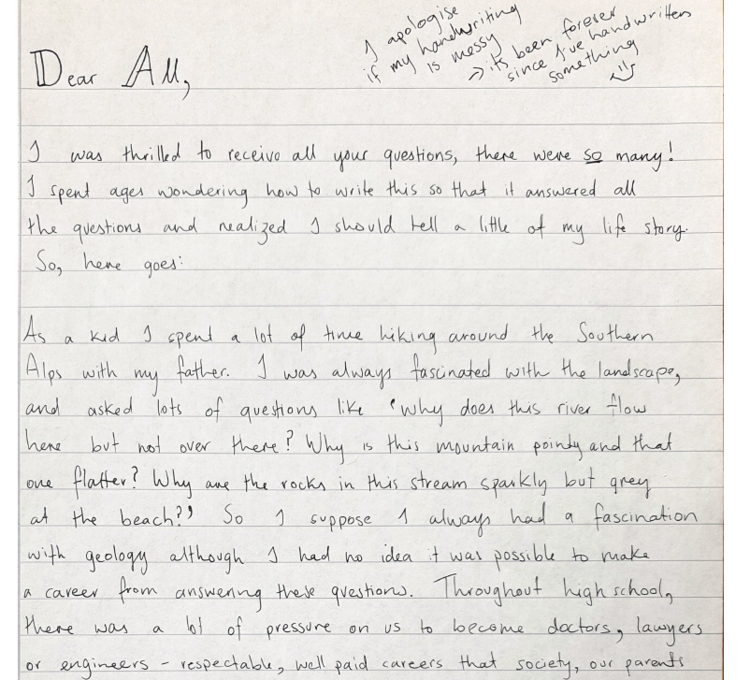
During the first phase of the project, the AKMA team designed teaching materials for the teachers involved in the Polaroid project. During the classroom discussion, the teachers and students discussed what a research process looks like and how research ships are used in search of answers to important scientific questions. After this, the students were tasked with writing (by hand) questions to “their” scientist to find out more about them, their science and the AKMA research expedition. Once the scientists received these questions, they set about answering the students with another hand-written letter. This turned out to be rather hard work since the students had written many interesting questions and there was a lot to describe and tell.


Then the scientists went on the research expedition. Amongst all the scientific equipment, they also had a polaroid camera each and a stack of negatives. They made wonderful photo albums about their experiences onboard and described what was happening.
After the process is complete, we will ask the students/teachers/scientists to evaluate the Polaroid project to see if these “retro” communications methods helped to create a meaningful and more personal dialogue. We shall see.
We at the AKMA project are committed to inspiring the future generation of ocean scientists. Our current master projects range from geochemistry, geophysics to ecology, biology and geo-ecology. Get in touch if you are interested in a master project with the AKMA project.
CATHRIN WITTIG
Hei, I’m Cathrin Wittig from the University of Kiel, Germany (CAU). I have a Bachelors degree in Geology and wrote my thesis about the “Fingerprinting of marine Tephra Layers in the eastern Aegean sea” at GEOMAR (Helmholtz-Zentrum für Ozeanforschung) in Kiel. I am now working towards a Master degree, in collaboration with the AKMA Project with Prof. Dr. Giuliana Panieri (CAGE) and Prof. Dr. Klaus Wallmann (GEOMAR) as my main supervisors and Dr. Claudio Argentino (CAGE) as my co-supervisor.

The project focuses on the biogeochemical processes in the shallow sediment in the area of the gas hydrate bearing Håkon Mosby Mud Volcano, which is located on the margin between the SW Barents sea and the Norwegian sea. As typical for a mud volcano there are warm, methane-rich fluids and mud ascending from the subsurface up into the shallow sediments and the water column, fueling a vast number of unique biogeochemical processes coupled with microbial activity. My research will cover two gravity cores (taken during the research expedition CAGE-20-3) and five push cores (taken during the research expedition CAGE-21-1) and I will use sedimentological and geochemical techniques to uncover the methane emission history and the biogeochemical processes in the gas hydrate bearing sediments of the Håkon Mosby Mud Volcano.
MARIE HOFF
I have been working on my master thesis at UiT - The Arctic University of Norway since March 2022 under the supervision of Giuliana Panieri and Claudio Argentino from CAGE and Andreas Kappler from the University of Tübingen. My thesis aims to better understand the impact of copper mine tailings on the submarine environment in Repparfjord in Northern Norway. Mine tailings are the waste leftover after the ore has been extracted from the mines - tailings usually are made up of crushed rock, water, trace amounts of metals and the additives used in processing. I am analysing the sediment porewater geochemistry and investigating the status of the biological communities living in and on the seafloor.
I have a bachelors in geo-ecology from the Eberhard Karls University in Tübingen where I studied the metabolism of bacteria who derive energy from reducing iron. I am currently in Tromsø taking courses and working on my master thesis on an Erasmus exchange with the aim of finishing my master in geo-ecology later this year.
 Marie Hoff collecting and analysing the sediment porewater geochemistry.
Marie Hoff collecting and analysing the sediment porewater geochemistry.
JOÃO BALSA
My name is João Balsa and I am from Évora in Portugal. I obtained my Bachelors degree in Biology and I am currently completing my Master degree in Marine and Coastal Systems, at Universidade do Algarve. My dissertation aims to study the meiofauna assemblages from cold seeps in the Arctic, a topic developed within the scope of the AKMA Project, with Dr. Sofia Ramalho (Universidade de Aveiro, Portugal) and Prof. Giuliana Panieri (CAGE).

Cold seeps are highly productive areas where faunal communities often display adaptations that allow them to survive, even thrive, despite the methane seepage activity and toxic sulphide-enriched sediment conditions. My research is focused on studying metazoan meiofauna. Meiofauna is a term used to group animals that are smaller than 1mm and metazoa are multicellular animals. Nematodes (tiny worms) are a type of metazoan meiofauna that are among the most diverse group of animals in marine sediments and are key in maintaining ecosystem functions like carbon and nutrient cycling. Very few studies have investigated nematodes inhabiting methane seeps, with a total lack of studies in the Arctic Ocean. The main objective of my thesis is to understand nematode community composition as well as their structural and functional diversity in methane seep sites offshore Svalbard and this work will help to fill the knowledge gap of nematodes in and around Arctic methane seep sites.
.jpg)
ABIDEMI ALEX AKINSELURE
I am Abidemi Alex Akinselure, from Nigeria and a master student at the Department of Geosciences, UiT - The Arctic University of Norway. I am working towards my master thesis with CAGE under the supervision of Giuliana Panieri and Claudio Argentino.
My thesis focuses on investigating methane seepage at the Svyatogor Ridge in the Fram Strait. The aim of my thesis is to reconstruct seepage history from this site with the use of foraminiferal geochemistry (stable carbon and oxygen isotopes of the tests) coupled with some other proxies such as the sediment and porewater geochemistry and organic compounds of the sediments.

The training I received during the course of this thesis includes splitting and describing cores, sampling sediments at intervals, sieving sediment samples and picking foraminifera from the sediment. I also interpret the stable carbon and oxygen isotopes of the foraminifera tests, interpret the source of organic matter using carbon/nitrogen ratios and use sediment and porewater geochemistry to determine certain processes that are ongoing or that have ceased within the sediments.
VILLADS DYRVED HOLM
My name is Villads Dyrved Holm, and I am finishing my Master’s degree in geology. Under the supervision of Giuliana Panieri from CAGE and Jan Pawlowski (IOPAN, Poland and ID-gene diagnostics), I have been studying the ecology of seep-related foraminifera, both from a classical micropaleontological and a molecular approach. Foraminifera have proved helpful as proxies for paleo-methane emissions, primarily based on the stable isotopic signature of their fossilized tests. The ecology of seep-related foraminifera communities remains a debated topic, and further insight into the matter could highlight potential bioindicator species.
During the AKMA2 scientific cruise in 2022, I sampled foraminifera from active seep sites, specifically the Vestnesa and Svyatogor ridges, to study the living benthic communities at these sites. At the University of Geneva, I participated in extracting and amplifying foram DNA.
This allows the study of potential genetic adaptations to seep environments and expands the available database for future metagenomic studies. At UiT, my work has revolved around more typical micropaleontological picking, counting and identifying forams under a microscope to quantify ecological parameters at seep sites.

ALBA MIGLIARESE
My name is Alba Serena Migliarese Caputi and I am a master student in Marine Sciences at the University of Milano Bicocca – Italy. My thesis project was subdivided into 2 parts, one in Tromso and the other in Milan, where I started to work once back in Italy.
I worked on my master thesis at UiT - The Arctic University of Norway from September 2022 to December 2022, under the supervision of Giuliana Panieri and Claudio Argentino (CAGE) and Alessandra Savini and Luca Fallati (UNIMIB).
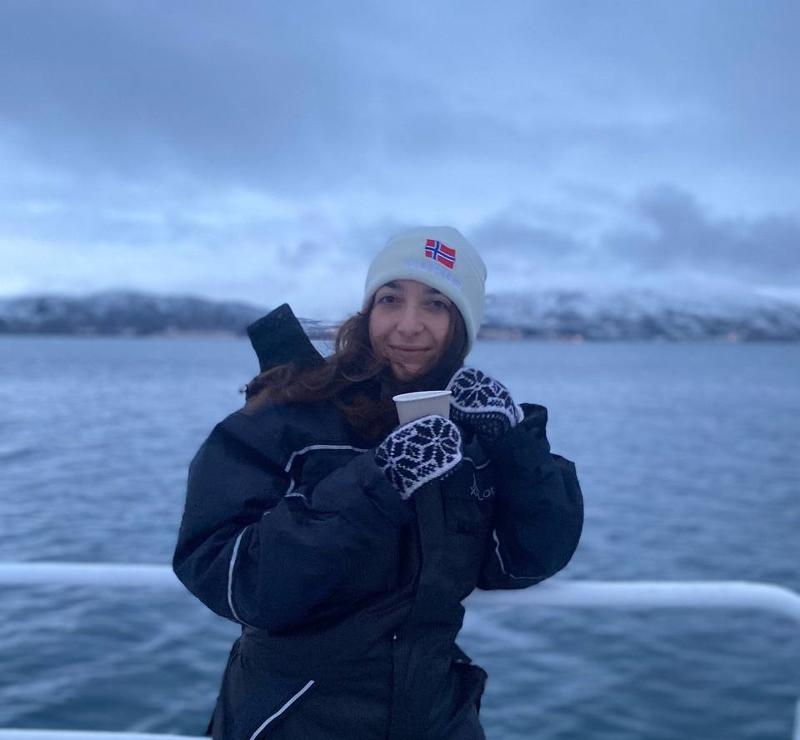
My master thesis is entitled ” Methane cold seeps in the Arctic Ocean: Habitat mapping and micropaleontological characterization of a deep sea giant pockmark in the SW Vestnesa Ridge (offshore Svalbard)" It focuses on:
1) analysis of sediment samples collected during the AKMA 2/Ocean Sesnes cruises following a standard procedure to characterize (at the genus and species level) benthic foraminifera living at cold seeps.
2) processing and analysis of multiscale remote acoustic data (Multibeam depth measurements and backscattering) and visual observations acquired using a Remotely Operated Vehicle (ROV) in order to obtain orthomosaics of the surveyed areas. Photorealistic 3D representations of seep sites will be classified using E-cognition software, to create an accurate map representing the distribution of chemosynthetic communities at the seafloor.
Looking forward come back to Tromso!
FEDERICA RIVA
Hi! My name is Federica Riva and I am a geology master student from the University of Milano-Bicocca in Italy. Through the Erasmus Traineeship Program, I have the opportunity to work with the AKMA project in Tromsø.
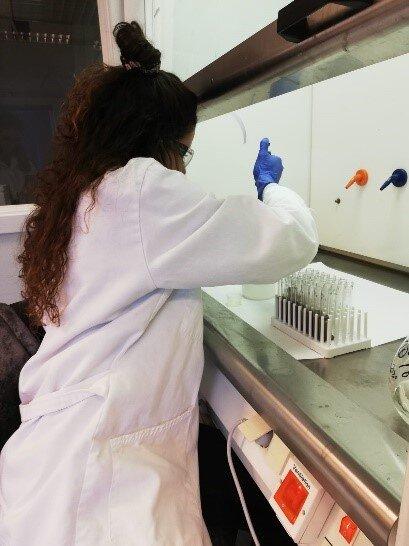
I wanted to do a Traineeship with the AKMA project because I have always been interested in studying Arctic environments and the impact of methane on the ocean and biological communities in extreme environments. My project focuses on understanding natural oil and gas seepage in the Arctic, from a geochemical and biological perspective. I hope to gain more knowledge of these processes from a more interdisciplinary perspective.
During the traineeship I will be working with three push cores and one blade core, collected during the AKMA expedition 2021, offshore Prins Karls Foreland. During the expedition, the team observed an oil slick on the sea surface and found bubbles containing oil seeping from the seafloor. In the lab, I will perform geochemical analyses, pore water analyses and foraminifera analyses on the samples. I started by treating the samples in order to measure the organic carbon and total nitrogen content. Using information about the amount of carbon and nitrogen in the samples, I can start to understand the source of the organic matter, which tells me about the environment at the time the organic matter was deposited.
FERESHTEH HEMMATEENEJAD
Hello, I am Fereshteh Hemmateenejad. I studied geology in my bachelors degree where I focussed on geological mapping. Currently, I am working towards my master degree in marine sciences at the University of Milano-Bicocca, Italy.

During my Erasmus traineeship programme at the University of Bergen, Norway, I had the opportunity to become part of the AKMA project family. Working in this environment with expert researcherss pushed me towards doing my master thesis on the same project. Under the supervision of Dr. Pedro Ribeiro, I identified and classified more than 10000 morphospecies from the photo-mosaics acquired during CAGE 20-7 expedition to Norskebanken. This project aims to find and analyse the correlation between the distribution of different species and different types of substrate.
I also used the same photo-mosaics and compared them to analyses of cores from the site to classify the substrate. By overlapping the previous species distribution with the substrate classification I could find where species and substrate overlapped and by performing statistical methods it is possible to find correlations between species and substrate.
A special thanks to Giuliana Panieri and Alessandra Savini who guided me through this journey and all the other researchers in the group who shared their experience and knowledge with me.
GIULIA GALIMBERTI
Hi, I am Giulia Galimberti and I am a master student studying marine sciences at the university of Milano-Bicocca. Thanks to the Erasmus Traineeship Programme I have the opportunity to stay in Tromsø and work with the AKMA project and Giuliana Panieri (CAGE). During my traineeship I will work with three cores that were collected during the AKMA expedition in 2021 from Prins Karls Foreland, offshore West Svalbard. The interest in this site is due to the intense gas seepage at the seafloor which, during the expedition in 2021 also seep oil bubbles.

The main goal of my traineeship programme is to identify the foraminifera communities living in this environment to understand how these extreme conditions affect which foraminifera can live there. To investigate this, I examine sediments taken from the seafloor at the site under a microscope and count the species of foraminifera present. The samples are stained with Rose Bengal, which stains living foraminifera pink and kept wet to preserve organic shells.
Once back in Milano, I will couple the results of the foraminifera analysis with interpretations of map data. During my stay in Tromsø, I also had the opportunity to participate in an expedition to Repparfjord on the Research Vessel Helmer Hanssen where I worked with the team during the sampling operations and helped preliminary habitat observations using the tow-camera system.
Forksningsdagene forskningsdagene, or Research Days, is an annual event in Norway where all types of research-based institutions are invited to present their activities to the public. Forskningsdagene began in 1995, to create enthusiasm for research and to convey what research is and what research results mean in our daily lives. This year, AKMA’s Giuliana Panieri, Matteus Lindgren and PhD Candidate Maximillian Weber participated in the ‘Order a Researcher’ portion of Forskningsdagene - where researchers offer availability to visit a classroom or company to talk about a their research. Giuliana Max and Matteus offered a virtual expedition aboard the Research Vessel Kronprins Haakon.
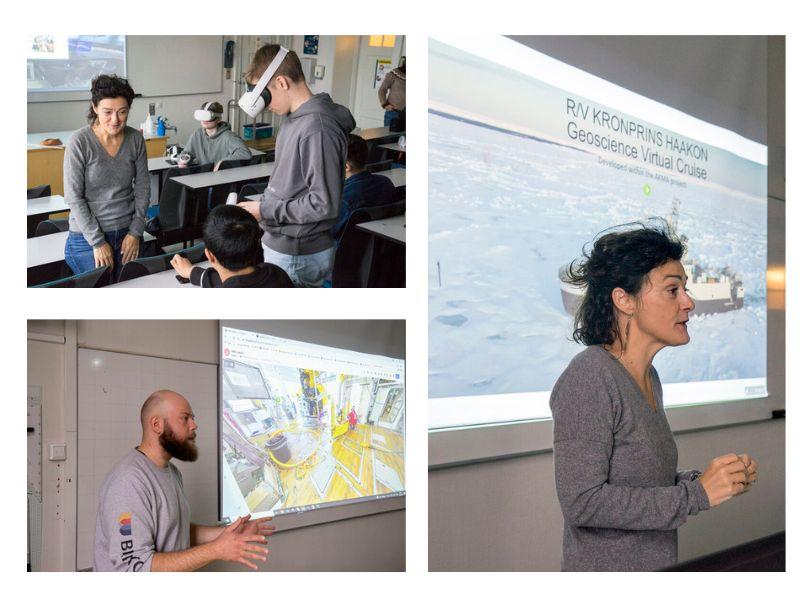
Giuliana Matteus and Max took students from two Tromsø schools onboard for the virtual expedition. The experience is offered both in person and digitally, and in person the students were able to use the virtual reality googles to walk around the Kronprins Haakon and explore for themselves.
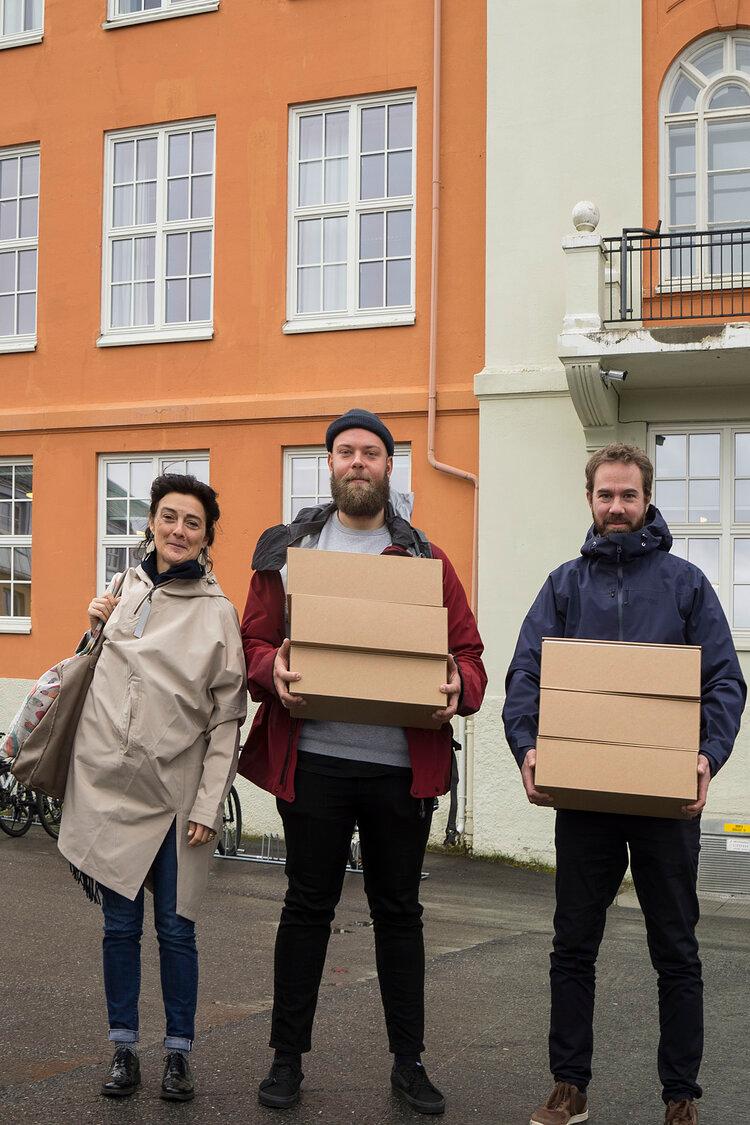

Emma is a high-school student in London who did her work-experience with the AKMA project. From background research to results she got to experience the process researchers employ when analyzing a data set. Below is her summary of the project.
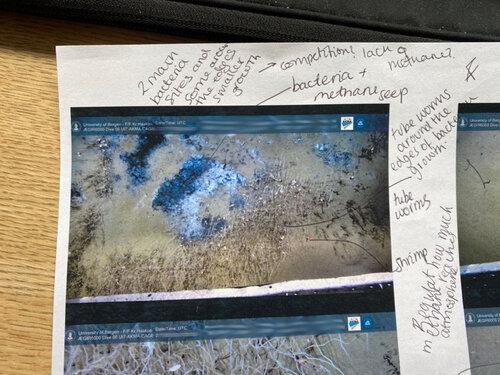
I was lucky enough to get the opportunity to work with Giuliana Panieri for a week, looking at the research of the AKMA project. Being able to work with AKMA project research as my work experience allowed me to learn about important biological and geological topics outside my syllabus at school.
To start my work experience, Giuliana and I talked over Zoom about the research that AKMA does on their scientific expeditions. After this I watched the videos on the website that explained what equipment they were using and what affect cold seeps had on the sedimentary record. On the website there were also a series of blogs written by students who were on the expedition - I found the blogs about the active oil seep and the human footprint on the Arctic most interesting. Looking at the website helped me gain more understanding of what the AKMA project was working towards and made me realize that what is happening so deep in the ocean affects life above the surface. After this I read through some slightly more complicated scientific articles. These went into detail about explaining the seeps, the processes in the Earth’s crust that maintained the seeps and how the methane seeps influence the ocean. Although these articles were hard to read, they were rewarding in the sense that I could understand (more than I did already) why data collection during expeditions is so vital.
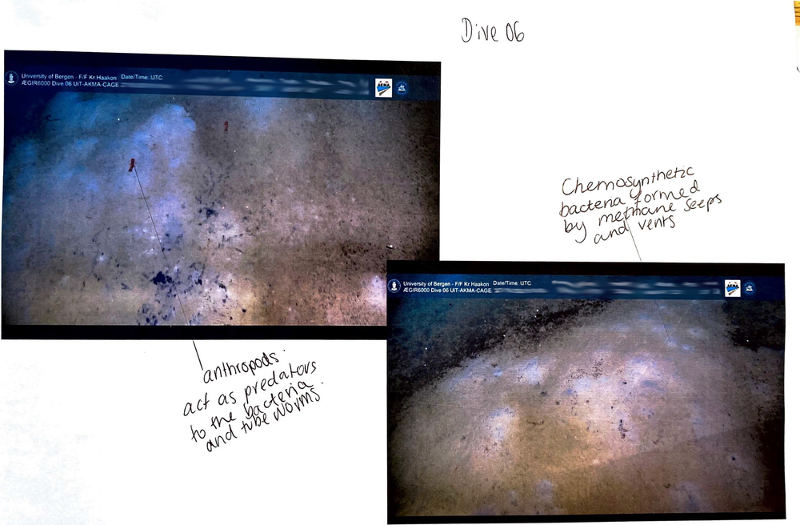
Giuliana and I met everyday on Zoom to discuss the article I read and the concepts that had been introduced through the videos and blogs on the AKMA website. After discussing and reading all the articles it was time for me to put my new knowledge into practice! I watched a video from a Remotely Operated Vehicle dive during the AKMA expedition 2021, and analyzed it, making notes of my findings. Going through the videos I was surprised by how, even when there was not a methane seep, there was still life so deep in the ocean. Suddenly the methane seep came into picture on the video. It consisted of two main methane seeps with many bacteria growing and a few surrounding bacterial mats. There was also a mass of tubeworms that grew in symbiosis with the bacteria. These tubeworms did not grow on the methane seeps but rather around the methane seeps. When going through my annotations I discovered this was due to the SMTZ - the Sulphir Methane Transition Zone. I also saw an arthropod, which I discovered was named Frank by the people on the expedition. In addition, I saw many small silver/blue fish near the outskirts of the tubeworms. It was wonderful and fascinating to see such a diverse range of life amongst the bacteria mats and tubeworms.
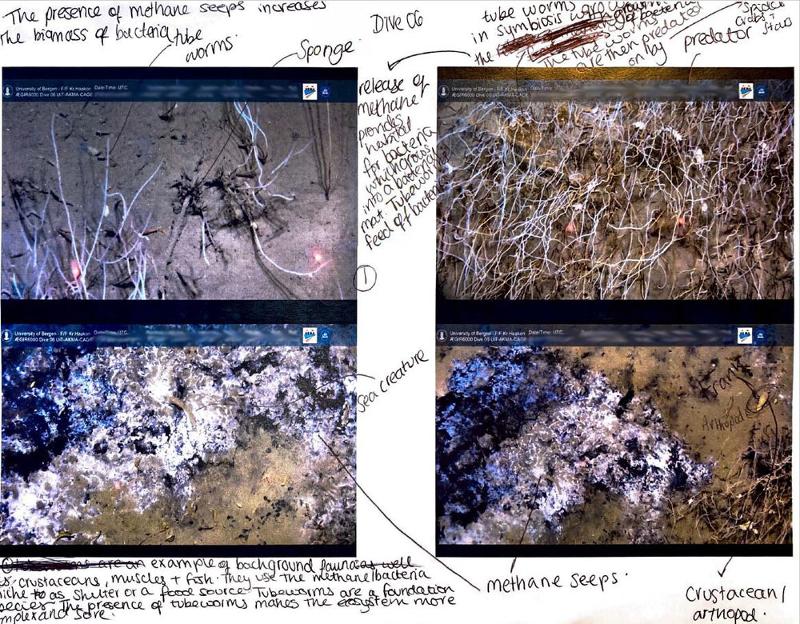
I learned so much from the articles, website and dive videos and am very grateful that I was able to work with Giuliana and expand my knowledge of the ocean even more.
-Emma C
In 2021 two students from the University of Milano-Bicocca worked in AKMA student partnership projects. Both these projects are detailed in the introductory videos below.
While we were at sea, during the AKMA 1 expedition in 2021 we were able to connect to shore to share our experiences aboard the research vessel Kronprins Haakon. In conjunction with the Polaroid Project, we connected with schools in Italy, France and Norway to share our experiences at sea. Topics we discussed with the classes ranged from the food aboard, to our fields of research to broader questions about science and society. AKMA early career researchers were also able to visit the classes in person at the end of the expedition.
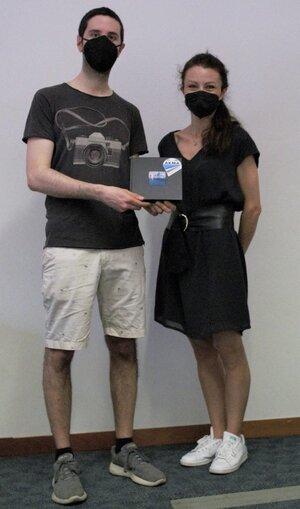
We also hosted the Department of Geoscience at the University of Tromsø, the Centre for Gas Hydrate, Environment and Climate and we gave a presentation from the research vessel for CHESS - Research School on changing climates in the coupled earth system.
.png)
During all the ship-shore connections, we were able to display a live feed of the scientific instrumentation, in particular the camera feed from the ROV Ægir when it was on the seafloor.
Akma project - Let's sustain the Climate is a project that allowed fourth-grade students from the Higher Technical Institutes “Giordano Bruno” (Budrio -Italy) to travel to Norway and meet Dr. Giuliana Panieri, researcher at the Arctic University of Tromso and responsible for the AKMA project. The project aimed to integrate the use of new digital technologies with the themes of environmental sustainability and internationalisation.
In Tromsø, they met the researchers, assisted them in the field and followed the study and the mapping of the Arctic seabed.
The project is developed within the Italian National Plan for Digital Education (Piano Nazionale Scuola Digitale — PNSD) that is a policy launched by the Ministry of Education, University and Research for setting up a comprehensive innovation strategy across Italy's school system and bringing it into the digital age.
HERE is the link to view the digital book creates from the students.
By Valentina Lanci
Ocean Senses inspires students participating in the Bridget SANTORINI SUMMER SCHOOL 2022
Fun activities to improve sensorial skills following
We use our senses every day. They are complex, and we rely heavily on them to provide us and our brains with important information which helps us not only perceive but also understand the world around us. Although they are active and working, we are often not actively aware of them.
But what if we actively engage our senses when exploring the outdoors? What more would we be able to discover about the world around us and ourselves?
In these videos, international students test their sensorial skills to explore and learn more about the marine ecosystem. It was a fun way to actively engage their senses to explore and discover more about the sea.
These videos have been realized by MSc student during the first BridgET Summer School in Santorini (3 - 14 October, 2022). The school was attended by 26 students from the six universities involved in the BridgET project coming from 13 different European and non-European countries. The Arctic University of Norway is also among the partners involved in the project and some of the Norwegian students took part in school activities.
During the summer school, the students used the Insta360 Pro 2 to shoot videos and photos of key research areas. The resulting products are 360° videos and images for virtual tours. These products will contribute to further deliverables of an immersive guideline to produce seamless land-to-sea geological models.
The videos we show below have also been shoot using the 360 Camera.
Students in the first video:
Fereshteh Hemmateenejad (UNIMIB)
Chiara Fusca (UNIMIB)
Elisaveta Sokolkova (Kiel University)
Daniel Berge Hansen (UiT)
Elisavet Nikoli (NKUA)
Student in the second video:
Vaso Petsakou (NKUA)
Zacharias De La Crouz (NKUA)
Joanna Causon Deguara (University of Malta)
Valmy Dorival (ULiège)
Farkhod Hakimov (ULiège)
Students in the third video:
Peter Bela Paloczy (UiT)
Anthony Van Keerberghen (ULiège)
Giulia Lisi /(UNIMIB)
Arete Belka (NKUA)
Sotiris Spanos (NKUA)
Students in the fourth video:
Giulia Galimberti (UNIMIB)
Mehdi Hosseini (Uit)
Akib Ahmed (ULiège)
Chiara Alina Tobisch (Kiel University)
Froso Varotsou (NKUA)
Students in the fifth video:
Florence Boham Gifty (Kiel University)
Benedict Bauer (Kiel University)
Luca Laudi (University of Malta)
Rami Mahmoud Kalfouni (University of Malta)
Spanos Sotiris (NKUA)
Martha Konstantopoulou (NKUA)
About the project
BridgET is designed to develop innovative and inclusive learning and teaching activities through the organization of dedicated summer schools for MSc students. Schools focus on giving students a hands-on experience of the variety of methods and approaches adopted in geospatial data acquisition and processing for the seamless generation of 3D models (i.e. Digital Terrain Models - DTM) of coastal regions.
Emphasis is always placed on the use of Virtual Reality (VR), not only as a tool to improve student engagement in the investigation and spatial understanding of coastal and submarine environments, but also as a vehicle to promote inclusion in the field of geosciences.
By Claudio Argentino
For the EGU23 General Assembly, the EGU Education and Outreach Committees connected high school teacher, Vibeke Aune, with geoscientist, Claudio Argentino, to teach a lesson plan on a topic relevant to Vibeke’s classroom curriculum: how scientists study methane in the Arctic Ocean. The lesson was live streamed online from Vibeke’s class in Tromsø, Norway, with geoscientist, Claudio, joining virtually from the Arctic University of Norway, also in Tromsø.
CLAUDIO ARGENTINO’S BLOG / Teaching about cold seeps during EGU23
During the last year’s General Assembly of the European Geoscience Union (EGU), I participated for the first time in a paired teaching lesson. This experience consists of a scientist, me in this case, and a teacher, Vibeke Aune, interacting and discussing about a specific scientific topic with students in a classroom.
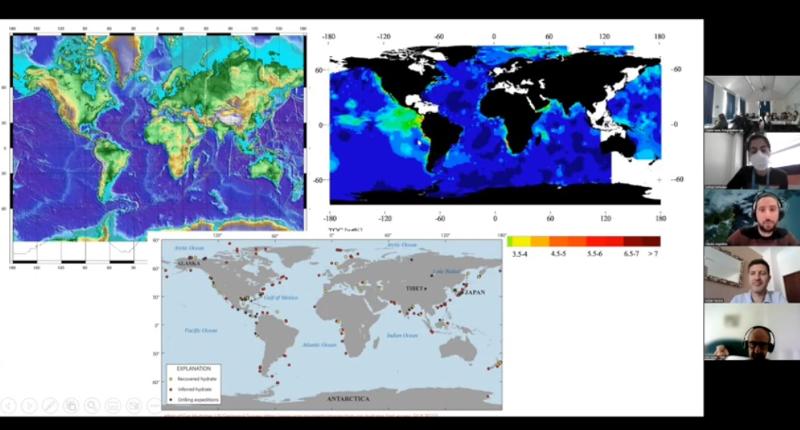
I was connected remotely whereas Vibeke was in the Kongsbakken upper secondary school in Tromsø. Solmaz Mohadjer mediated the entire session. My role was to introduce cold seeps to the students by showing some videos (active seeps with bubbling and fauna) and maps (topographic map, global distribution of organic matter and gas hydrates), and asking key questions such as:
What do you think that white spot at the seafloor is (referring to microbial mats)?
What do these maps show you?
Then what controls the distribution of cold seeps around the world?
My contributions were kept short, generally 5 minutes, to give the students enough time for group discussions. Vibeke stimulated the discussion in the classroom and then provided feedback from the students.
I enjoyed this type of teaching because it was highly interactive, and the students seemed really engaged.
This specific lesson plan was developed by Solmaz Mohadjer, Vibeke Aune, Giuliana Panieri, and Davide Oddone within the AKMA project, with some minor modifications from me. It is important to highlight the fact that this paired teaching scheme can be applied to all disciplines and adapted to a different target audience, leading to a memorable experience for the scientists, the teachers and the students.
For more information about this lesson plan and the EGU Teacher-Scientist pairing scheme, visit: https://egu.eu/36K06M/
For more information visit the EGU23 webpage: https://www.egu23.eu
The AKMAproject's legacy provides the basis for creating a programme that focuses on extreme environments.
Completing a project can bring to the surface feelings of loss, despair, sadness or emptiness. Every scientist and researcher know these feelings very well. But that's not the case with the AKMA project. The scientific enthusiasm, the harmonious partnership, and the educational value that the project has fostered throughout its course have laid the foundations for the creation of a new, amazing project: "Bridging the gap between marine and terrestrial extreme environments".
The main objective of this project is to train a new generation of geoscience students to make them aware of the tight interactions between biology and geology. In concrete, the project aims to develop a 5 ETC level course that explores extreme environmental conditions, including cold seeps, hydrothermal vents, and environments similar to icy moons. These extreme environments will be used as case studies to train the students on fundamental processes, enabling them to think and learn how biological, chemical and physical characteristics interact to shape those complex systems.

The project shares the vision of the iEarth's seed project (https://www.iearth.no/), which is an initiative to support teaching and learning collaboration across departments and universities. It aims to engage students in improving their learning environment, collecting data, developing teaching and learning in geosciences, and promoting the Scholarship of Teaching and Learning (SoTL). In line with this approach, the bachelor's course will be interdisciplinary and research-based, with a focus on geo-biochemistry. Co-creation methods will be used to empower students in the classroom and in their lives, as formative interactions make the content taught more relevant to them.
So keep your fingers crossed for this important new step that AKMA is helping to build.